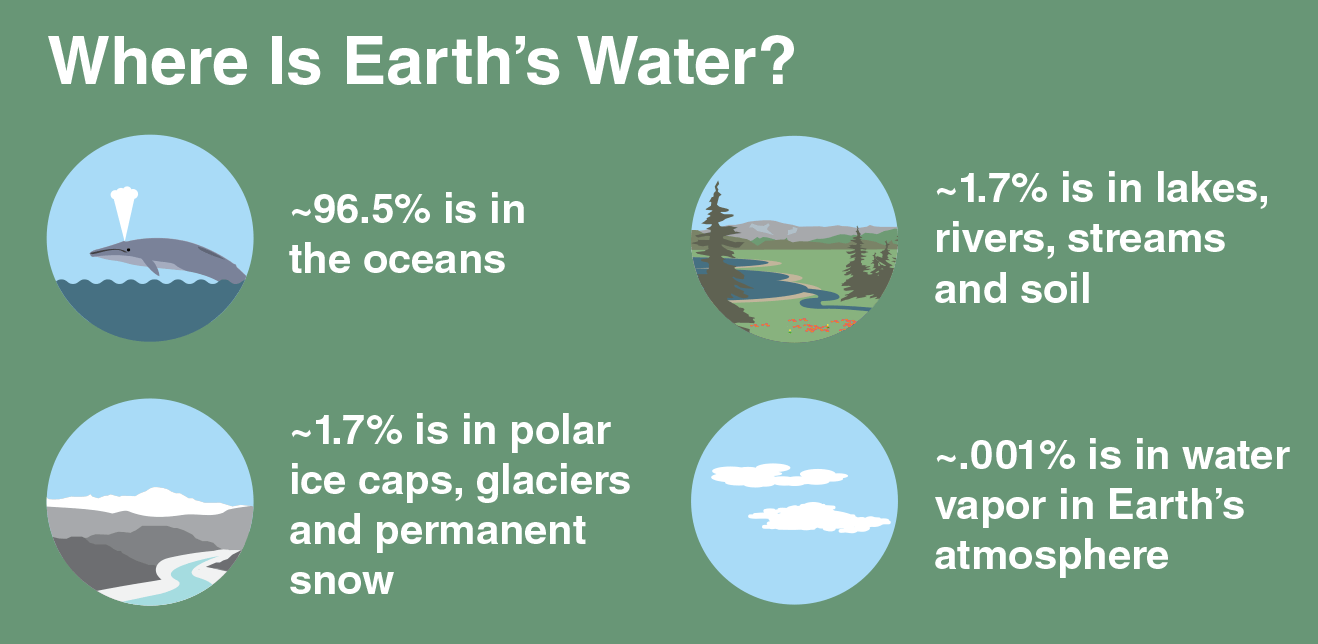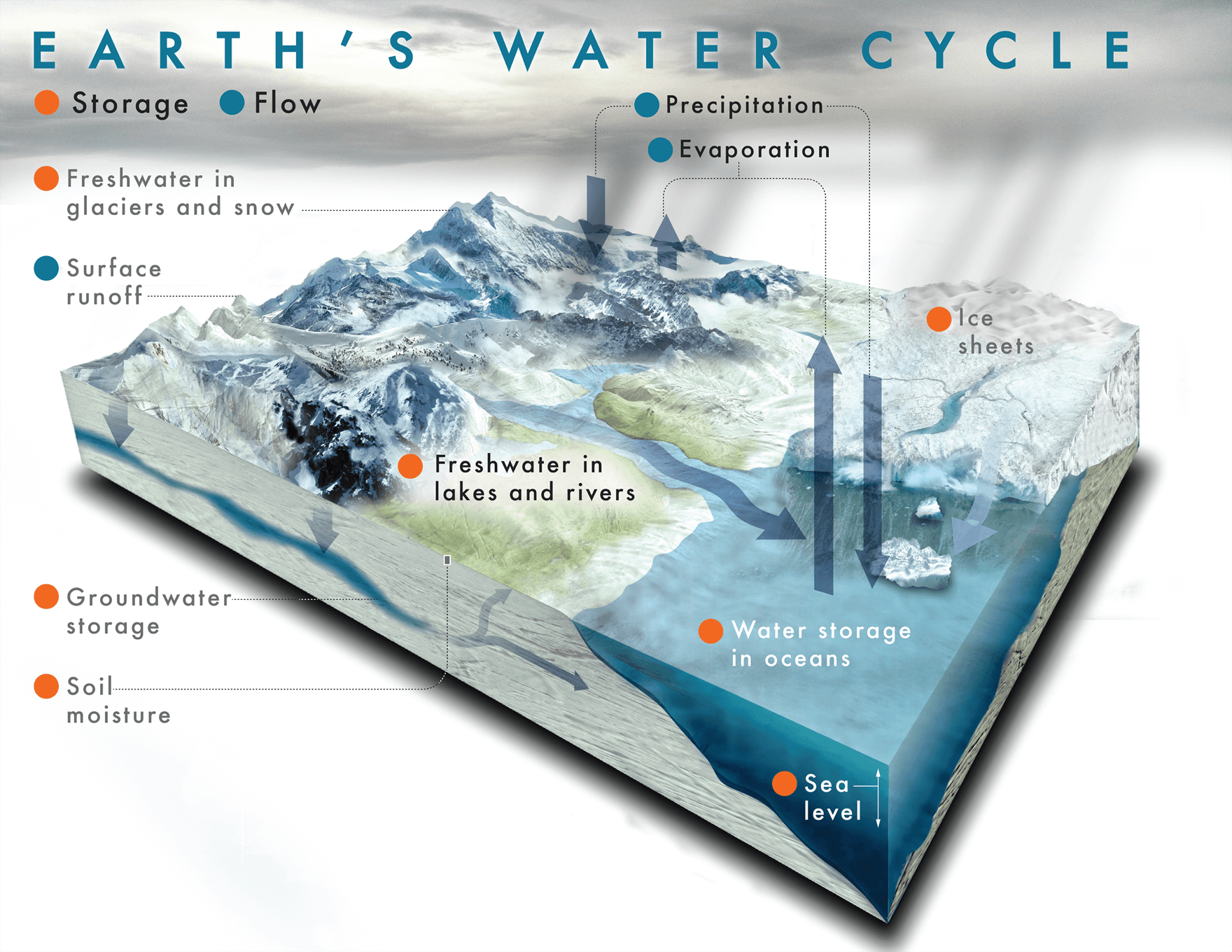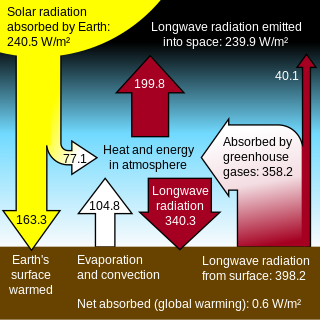AIM: TO LOOK AT THE WATER CYCLE AND HOW CLIMATE CHANGE IS AFFECTING IT.
Definition:

Scientific words:
- Evaporation. When water is heated by radiant energy it turns into water vapor.
- Transpiration. Evaporation from plants.
- Condensation. When water vapor cools, molecules join together and form clouds.
- Precipitation. When clouds get heavy the waters falls as rain, sleet, hail, or snow.
- Acidification: the action or process of making or becoming acidic.
We will be conducting an experiment that looks at the different ways that climate change is affecting the water cycle.
Two Images:
Two Images:

Findings:
Material:
- 2 Plastic bag (ziplock)
- Vivid pen
- A cup of water and half a cup of soda water.
- Food coloring
- Litmus paper (only for the one with soda water)
Steps:
- Grab a plastic bag (ziplock) it should be partly large.
- Grab a pen and start to draw the clouds, water, trees, and words.
- Pour a cup of water into the bag not too much.
- add at least two drops of food coloring the color of your choice but ideally blue
- Stick the bag on a window where the sun comes through regularly.
The Water Cycle: Bag 1
|
CO2 Water Cycle: Bag 2
Acid
|
Desert Water Cycle
Bag 3
| |
Does it cycle?
| Yes, it does | Yes | Yes |
Amount of Water
| 2 | 2 | 2 |
Acidity
| 1 | 2 | 1 |
Key: Water and acidity amount: 1 = none
2 = small drips
3 = large drips
Other comments:
Bag 1
- The water cycle bag 1 did not contain any form of acidity.
- In bag 1 there were effects that showed the process of the water cycle.
- In bag 1 it had created small drops of water.
Bag 2
- The CO2 water cycle bag contains small drips of acidity
- The special paper in the bag had not turned blue since the water cycle was very slow.
- Although the process of the water cycle was very slow it still worked
Bag 3
- For the desert water cycle bag, the water cycle we were trying to create was successful because of showing effects in the bag.
- The bag contained small drops of water
- It had not created any form of acidity in the bag.
Conclusion:
We created 3 kinds of bags that would all be related two the water cycle we made one with just water, the second with soda water, and the third with sand and a tiny bit of water. All bags contained small droplets of water but bags 1 and 2 did not contain any acidity apart from bag 2 since it had contained soda. As we were expecting well hoping all the bags water cycles had turned out successfully after showing signs of the process in the water cycle. We saw the bag fogging up which is condensation. Overall we were a bit disappointed since the paper did not turn blue but that's okay.
Draw a labeled diagram of the Water Cycle
Water cycle words:
- Precipitation
- Hurricanes
- Storms
- Evaporation
- Carbon Dioxide
- Water
- Oceans
- Water vapor
- Freshwater
- Flooding
SOLO Hexagons Activity
Water cycle words:





Water cycle words:
- Precipitation - Precipitation is when it rains after clouds are saturated and cannot obtain more liquid.
- Hurricanes - It is a storm with strong wind, rain, and hail most likely to be found in the tropical Caribbean.
- Storms - It is a weather that causes strong and violent wind and rain and sometimes lightning.
- Evaporation - Evaporation is when the sun's heat also known as radiation evaporates liquid into the sky.
- Carbon Dioxide - Carbon dioxide is a gas that is produced from burning fossil fuels like coal, and oil.
- Water - is a liquid substance that forms the ocean, lakes and also the source we use to drink from.
- Oceans - The ocean is part of the sea and also the habitat of marine life.
- Water vapor - Is the gas of water for example clouds, fog or when you heat up water and there is steam.
- Freshwater - Freshwater is the kind of water that is from the sea.
- Flooding - Flooding is where there is an overflow of water and can also be a matter of natural disaster that can be caused by underwater volcanoes or earthquakes that can cause large waves.
- Write about the following Climate Change concepts:
You can do these by powerpoint, embedding a movie, on your blog, on a doc or any other form of presentation. It is up to you.
- Precipitation - When it rains it can help the plants but it can also cause floods.
- Hurricanes - The amount of rainfall had been increased by climate change, it also destroys houses and can sometimes cause flooding.
- Storms - Since Climate change has changed the weather a lot it also caused many more storms.
- Evaporation - When the water evaporates it will come back as snow and rain but because of the climate it has increased the air temperature which causes more evaporation.
- Carbon Dioxide - Carbon dioxide is the main reason for climate change since it causes acid rain and pollution in the air.
- Water - Climate change has increased the temperature of the water which travels to cold places like Antarctica and melts the glaciers faster than how it used to be.
- Oceans - because of us humans littering, carbon dioxide, and greenhouse gases which cause the ocean to help the earth's climate.
- Water vapor - The water vapor is like greenhouse gases and once it is released into the air it increases the water temperature and is also warming carbon dioxide.
- Freshwater - involving climate the freshwater has changed over the decades because of climate change because it has caused acid rain, Climate change has also decreased the quality of our water and saltwater has also started to intrude into our water supplies.
- Flooding - Because of climate change and weather changes because of storm and hurricanes, it has caused many floods.
Picture:
ACIDIFICATION: HOW DOES CLIMATE CHANGE CONTRIBUTE TO THE ACIDIFICATION OF OUR OCEANS?
Definition:
It is where someone or something creates acid or making something become acidic.
The effects of climate change:
When humans burn more and more fossil fuel it creates carbon dioxide which is an acid and when it releases into the air, it makes the air hotter and the ocean hotter and hotter. but it is not only humans creating carbon dioxide there is also sea acid.
Picture:

Diagram of how it affects the water cycle.
DEFORESTATION AND CLIMATE CHANGE
DEFORESTATION: HOW DOES DEFORESTATION AFFECT CLIMATE CHANGE?
Deforestation Definition:
Deforestation is where someone, or a machine or any kind of action that clears an area of trees, for example, cutting down trees.
The effects it can do to climate change:
Trees absorb carbon dioxide and release oxygen, when we cut down trees or burn them down the tree releases it's containing carbon dioxide. Since carbon dioxide is a greenhouse gas. It starts to float around in the atmosphere and will create a cover or for example, acts as a greenhouse. normally if our atmosphere was not affected by carbon dioxide it would prevent the strong heat rays from entering, and the light will bounce back up into space. But now that carbon dioxide created holes in our atmosphere which allows the strong heat rays to enter and because the carbon dioxide has created a glass house kind of atmosphere it allows the sunray to bounce on earth and go up and down normally it would go back up to space.
Picture:

Diagram of how it affects the water cycle.

ICECAP MELT: HOW DOES ICECAP MELT AFFECT CLIMATE CHANGE?
Definition:
It is where icecap melts because of climate change which causes the water to get warmer and when the sea level rises it is much easier for it to melt.
How it affects climate change:
Because icecaps are a dark color it absorbs more sunlight and also releases it in the air which helps climate change and that heat warms the air and melts the icecaps. Once the ice caps are melted there will cause a sea-level rise and more evaporation which will be faster.
Because icecaps are a dark color it absorbs more sunlight and also releases it in the air which helps climate change and that heat warms the air and melts the icecaps. Once the ice caps are melted there will cause a sea-level rise and more evaporation which will be faster.
Picture:
Diagram of how it affects the water cycle.

WATER VAPOUR: HOW DOES CLIMATE CHANGE CONTRIBUTE TO WATER VAPOUR AND EVAPORATION?
Definition:
Water vapor is a gas it is caused by evaporation or boiling water but that is aqueous vapor water vapor is invisible.
How does it affect climate change:
When we dump greenhouse gas into the air, of course, you know it makes the air humid and warmer but because of water vapor which is a greenhouse gas itself helps the carbon dioxide which makes it worse.
Picture:




No comments:
Post a Comment
Please structure your comments as follows:
Positive - Something done well
Thoughtful - A sentence to let us know you actually read/watched or listened to what they had to say
Helpful - Give some ideas for next time or Ask a question you want to know more about